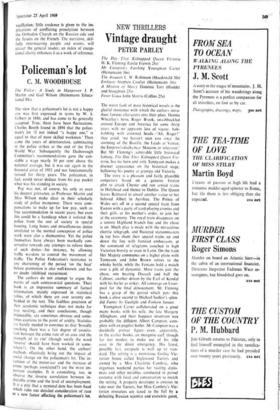Policeman's lot C. I. WOODHOUSE
The Police: A Study in Manpower J. P. Martin and Gail Wilson (Heinemann Educa- tional 84s) The view that a policeman's lot is not a happy one was first expressed in terms by W. S. Gilbert in 1880, and has come to be generally accepted. True, there have been fluctuations. Charles Booth found in 1894 that the police- man's lot 'if not indeed "a happy one," is equal to that of most skilled workmen.' Then came the years of deterioration, culminating in the police strikes at the end of the First World War. Subsequently the Desborough Committee's recommendations gave the con- stable a wage nearly 30 per cent above the national average, but it was cut again in the financial crisis of 1931 and not fundamentally revised for thirty years. The policeman, in fact, could never deduce from his pay packet what was his standing in society.
Pay was not, of course, his only or even his deepest grievance, as Professor Martin and Miss Wilson make clear in their scholarly study of police manpower. There were com- pensations to make up for low pay, such as free accommodation in recent years; but even this could be a handicap when it isolated the police from the rest of society in special housing. Long hours and miscellaneous duties unrelated to the normal conception of police work were also a disincentive. Yet the police themselves have always been markedly con- servative towards any attempts to relieve them of such duties—for instance, by allowing traffic wardens to control the movement of traffic. The Police Federation's resistance to any shortening of the period 'on the beat' before promotion is also well-known, and has no doubt inhibited recruitment.
The authors do not attempt to argue the merits of such controversial questions. Their book is an impressive summary of factual information, mainly expressed in statistical tables, of which there are over seventy em- bedded in the text. The faultless precision of their academic technique does not make for easy reading, , and their conclusions, though impeccable, are sometimes obvious and some- times cautious to the point of aridity. Statistics are hardly needed to convince us that 'broadly speaking there was a fair degree of associa- tioh between the crime rate of an area and the strength of its cm' (though surely the word `inverse' should have been worked in some- where?). On the other hand, the authors' methods effectively bring out the impact of social change on the policeman's lot. The in- vention of the- motor-car and the increase of crime (perhaps associated?) are the mast im- portant examples. It is astonishing, too, to observe the inverse correlation between in- dictable crime and the level of unemployment. It is a pity that a terminal date has been fixed which rutes out detailed consideration of race as a new factor affecting the policeman's lot.










































 Previous page
Previous page